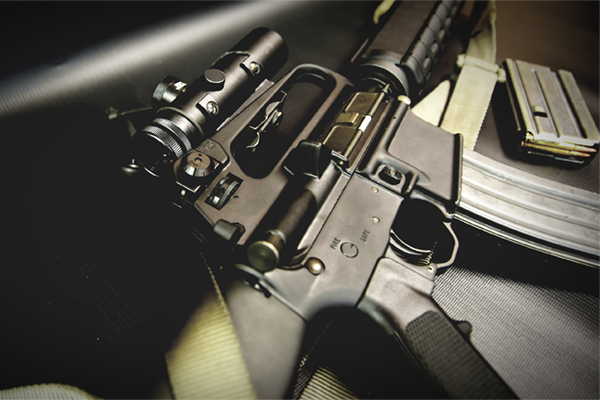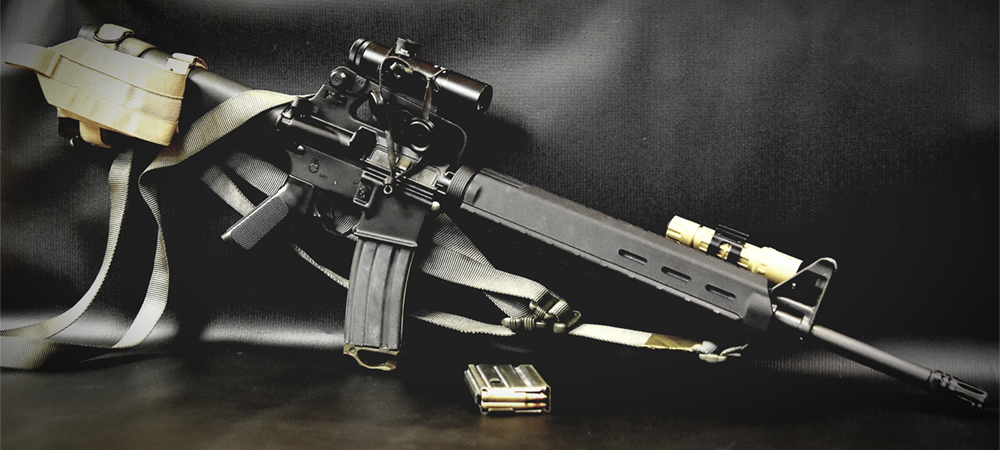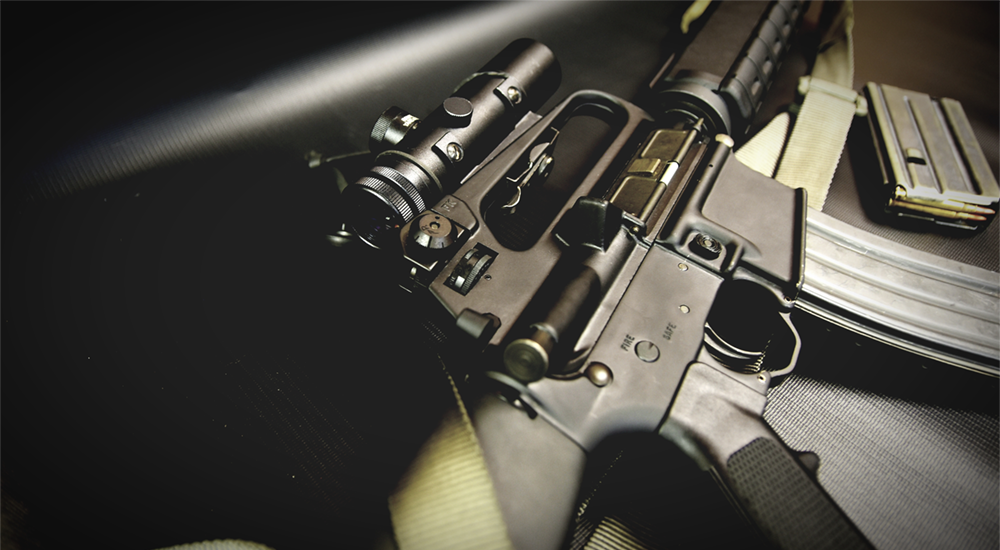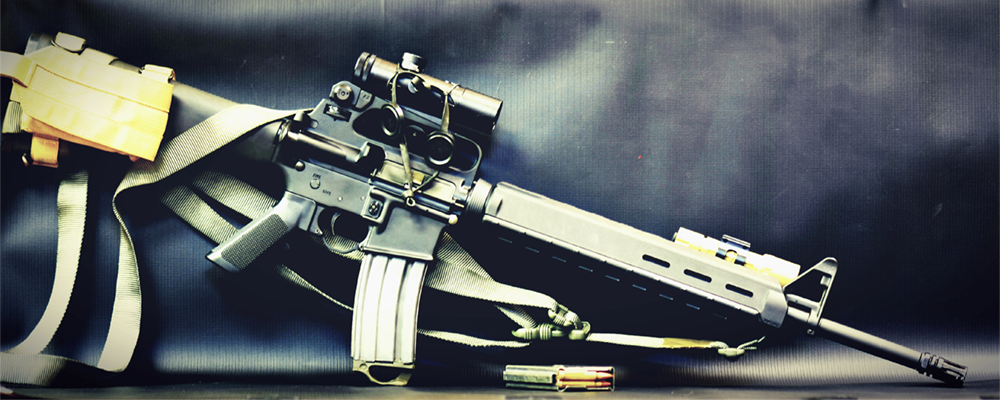
By Carlos Huerta
The M16 rifle is the longest serving weapon in military history, and to this day, it continues to evolve. The M16 was the US military’s adoption of the civilian AR-15 developed by Eugene Stoner in the late 1950s. In early-mid 1960s, it became the standard-issue infantry rifle, and since then it has gained popularity in many countries. Over the years, the US has supplied a significant amount of these rifles to allies. Chambered in 5.56mm NATO, this is the most-produced firearm in this caliber, and it maintains technical superiority in three areas: range, accuracy, and weight. The M16 is easily operated and the similarity to the AR platform allows users to maintain each with ease. It is easily recognized by its signature carry handle and large triangular front sight, otherwise referred to as an A2 post.

AR-15 vs. M16
What sets the M16 apart from its civilian counterpart is the longer barrel and greater weight. The 20in barrel assists with accuracy and increases its maximum effective range. When compared to the AR, it weighs in at 6.37 lbs unloaded only 7.51 lbs when loaded to capacity. The overall length of the weapon is 39.5in.
The US Army demanded a lightweight rifle and Stoner responded by making adjustments to the weapon’s construction. Unlike other rifles at the time, the design uses aluminum in place of steel and fiberglass in place of wood. To meet the criteria, the lightweight configuration was the driving emphasis of the entire design, resulting in the rifle weighing around 30% less than the AK-47. This allowed for a more comfortable carry, especially since the rounds are much lighter. Carrying a rifle with less weight makes all the difference, especially when trekking. Unfortunately, the M16 is not capable of withstanding similar abuse like other rifles as the fiberglass stock is not as durable as wood.

Design
The M16 is one of the most iconic rifles with a strikingly modern design. The first units issued arrived with American troops to Vietnam in 1963. The initial production model was designated as the M16A1. Over the years, many variants have been released. The slimmer 5.56mm round is only half the weight of the 7.62×39 cartridge. Not only does it weigh less, it is also significantly more accurate with a longer range. While this round travels faster, it does not have the same impact strength as other calibers. This rifle does have a smoother operation and has less felt recoil than its competitors, which is attributed to the interval design. The buttstock is aligned with the barrel to reduce muzzle climb making it easier to control during full auto fire. The M16 has a fire rate of roughly 450 rounds per minute.
Field Use
Field stripping is a key factor when pertaining to firearms as the weapon may jam if it gets too dirty. Experiencing a weapon jam can be disastrous in the middle of a firefight. One issue the M16 faced in the days of Vietnam was the lack of cleaning. When it first hit the jungles, soldiers were told they were holding a “self-cleaning rifle” and were not issued cleaning kits nor were they trained on maintaining their battle weapon. As a result, many experienced frequent jamming and malfunctions. Within a year, cleaning kits were issued which resolved most of the malfunction issues. Like the AR, the M16 is a complex weapon design comprised of many smaller parts and must be well cleaned and oiled. The AK on the other hand could be thrown into dirt, mud, or sand and fire without issue. During the early service time of the M16, the malfunction rate was roughly two out of every thousand rounds fired. Once these problems were fixed, reliability issues significantly decreased.
It is clear the M16 was designed for superior accuracy from the beginning. It is known for its fixed A2 style sights mounted to the front and rear of the barrel. The M16 is capable of mounting accessories to improve performance in combat. This rifle can be fitted with a bayonet and is also designed to support a simple clamp-style bipod. It is also compatible with a 40mm under barrel grenade launcher, and the rifle can launch a 22mm grenade without the use of an adapter. Certain versions also include a 12-gauge shotgun mounted under the barrel. Modern-day versions of the M16 include a removable carry handle with the advent of the picatinny accessory rail. It is an extremely adaptable weapon and has the advantage in terms of accessories and modularity.

Strengths And Weaknesses
The M16 has both strengths and weaknesses like all firearms. As we covered earlier, proper maintenance is a must as grease and carbon can gradually build up if not properly cared for. In my personal opinion, this rifle shoots well, but does not feel “lightweight,” especially when handling for extended periods of time. It is also not the most compatible for close-quarter combat or room clearing since the longer barrel makes it cumbersome to manipulate in tight corners or areas. This can be used as a home-defense weapon; however, the longer barrel will give you greater penetration which can be disastrous in closer engagements. This would mean the round will penetrate through your target and potentially impact whatever is beyond your engagement area.
Final Thoughts
Overall, the M16 is a larger rifle than the AR-15 we’re used to, but it shoots very well. When adding a scope and flashlight to mine, the weight was noticeably present. The M16 has earned its spot in American history and is also showcased in numerous movies and video games, including The A-Team, Lethal Weapon, Rambo, and many James Bond films. It is still popular and well-known in today’s society; however, a rifle’s service life validates its overall performance. Variants of this rifle remain in production and are still in use with some militaries today.




Leave a Reply